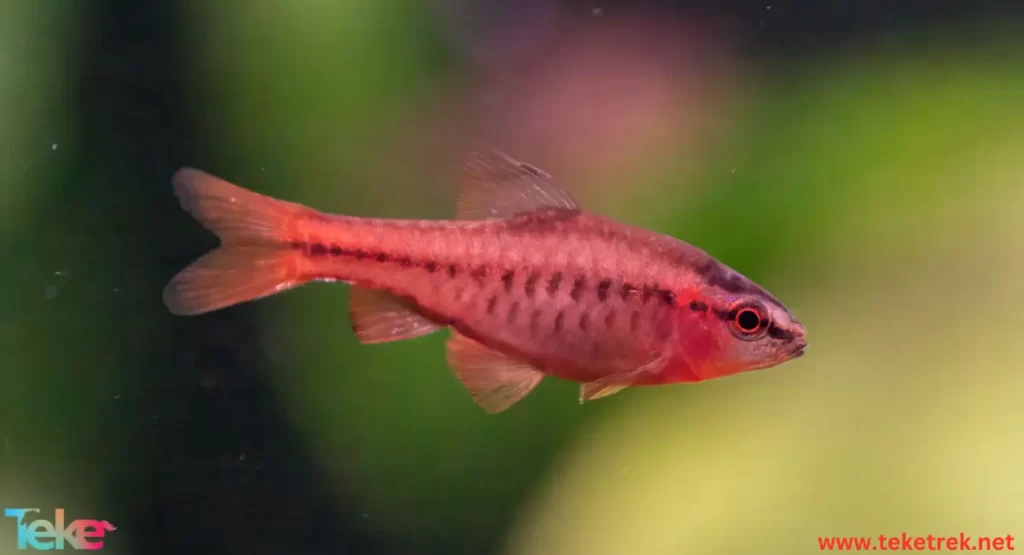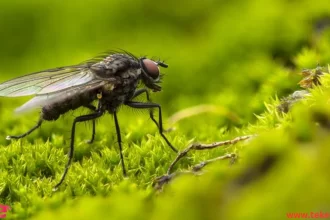The Rosy Barbs are beautiful ornamental fish that live in freshwater, and give the place they are in a pink flash that catches the eye. With her bright colors and gentle movements, she creates a vibrant artistic picture.
The pink fish is considered one of the most popular species, as many people want to raise it and add it to small home ponds thanks to its peaceful nature and great ability to adapt.
Let’s learn more about it from teketrek.

An introductory overview of the Rosy Barb fish
Firstly, it must be noted that the original homeland of the Rosie Barb is northern India, Bengal, Pakistan, Bangladesh, in addition to Nepal and Afghanistan. Various groups have also been observed in Australia, Mexico, Colombia, Singapore and Puerto Rico.
It is worth noting that this species prefers to live in subtropical climates, where there are lakes, streams, and fast-flowing water. Below we will mention its scientific classification:
Genus: Pythia
Class: Actinomycetes
Kingdom: Animals
Division: Vertebrates
Scientific name: Pethia conchonius
What are the characteristics of Rosy Barb fish?
The pink barb fish is known in Latin as Puntius conchonius. It has a simple appearance that gives it more distinction, and we will mention its most prominent features below:
The size of Rosy Barbs ranges between 10 and 15 cm, as it is considered the largest species of barb, and its adult size reaches 6 cm
The female Rosie Barb has a bright golden body color, which is decorated with a black dot in the last third of the body.
The male is known for its golden and red color, with black spots on the dorsal fin and near the nape.
The Rosie Barb has short, transparent anal and dorsal fins that are the same color as the body, but lacks a mental fin.
The Rosie Barb has a forked tail
This fish is known for its round body shape, and it has medium-sized teeth.
It is worth noting that we can differentiate between the male Rosy Barb fish and the female by looking at the sides during the mating season, where the male has a red color while the female has a yellow color.
Ideal environment
As we mentioned previously, the pink barb is one of the fish that is easy to raise thanks to its unique characteristics, so if you want to add it to your home aquarium, you must consider the following points:
Rosie Barb prefers to live in fresh water that does not contain a high percentage of acids.
You must pay attention to changing the water permanently.
The temperature should range between 64-73 Fahrenheit (18-23 Celsius).
The aquarium contains an effective filtration system and a filter with a waterfall outlet, to ensure continuous addition of oxygen to the water.
Providing a suitable diet containing live aquatic invertebrates that it is advisable to peel, in addition to dried food and vegetables such as potatoes, lettuce and zucchini.
Rosie Barb does not want to be left alone, so the minimum number of fish in one tank should be 2, and the ideal number is 6 fish.
The size of the tank should not be less than 60 cm, as this fish can swim at various levels – bottom, middle and surface.
The pH level should be from 0.6 to 0.7.
The water hardness should be between 4 and 10 kHz.
Rosy Barbs prefer low light.
In adulthood, the Rosie Barb is known to be aggressive towards other fish, wanting to bite off their fins.
As a result, it is not preferable to have slow-moving fish or fish with long fins in the same tank.
It is best to move your Rosy Barb indoors in the winter, if the area in which it lives is subject to cold weather.
Adhering to all the points we mentioned is one of the basics of success in keeping Rosy Barb fish in home tanks, which will make you have an enjoyable experience in the world of fish farming.
Reproduction stages of the Rosy Barb fish
When the Rosy Barb’s breeding season begins, the males will resort to displaying chasing and imaginary mating behaviors by repeatedly pushing her head and abdomen, whereby the female appears swollen with eggs, then scatters hundreds of them so that the male, in turn, works to fertilize them.
However, attention must be paid to the necessity of exposing the glass of the aquarium to sunlight in the morning during the spawning period.
The eggs hatch after about 30 hours and produce swimming larvae after 6 days, which requires you to feed them liquid larval food, infusoria, or small local shrimp at least three times a day.
You must pay attention to the need to change the water quickly, as the presence of uneaten foods spoils the aquarium and thus affects its survival.
It is worth noting that female and male Rosy Barbs do not have any parental feelings. They do not care for the young, and may resort to eating them if they are not removed directly from the aquarium.
Diseases to which the Rosy Barb fish is exposed
The Rosie Barb is like any other living creature. It may be exposed to many diseases, perhaps the most prominent of which is white spot disease, which is widespread in fresh water, and which may cause many harms.
The cause of white spot disease is an external parasite, the symptoms of which appear in the form of white spots spread throughout the body. It should be noted that it is a highly contagious disease.
This disease can be treated using some medications that do not require a prescription, as copper-containing medications are among the best options for treating white spot disease quickly.
The most important steps that must be taken are
Continuously monitor the water situation and change it regularly.
Continuously measuring temperatures.
Monitor pH levels.
Maintain low levels of nitrates and ammonia.
Rosie Barb’s diet
Rosie Barb is a species that can eat any food offered to it. Below we will mention the most important foods that will provide them with their needs and maintain their survival when they are in home tanks:
Granules or flakes contain all the important nutrients for their growth.
Frozen and freeze-dried food.
Plant foods such as zucchini, peas, spinach and lettuce.
Salted shrimp.
When found in nature, it relies on protein-rich foods such as (crustaceans, small insects, and worms) in its diet.

FAQs about the Rosie Yarab fish
What are other names for Rosie Barb?
The Rosy Yarp fish is called the Paris Rosy.
Are rosy barb fish aggressive?
they can be aggressive towards fish
Will rosy barbs eat snails?
Yes, rosy barbs will eat snails.
How long do rosy barb fish live?
Rosy Barb lifespan is 5 to 10 years.
Do barb fish sleep?
Yes, they need to sleep to stay healy.
In conclusion, we can only say that Rosie Barb is a self-contained world whose details reflect the creativity and greatness of theo Creator.
It is also an ideal choice for all people looking for pets to add to their homes





